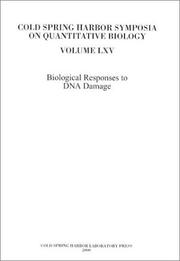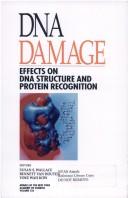| Listing 1 - 10 of 208 | << page >> |
Sort by
|
Book
Year: 2018 Publisher: Basel : MDPI - Multidisciplinary Digital Publishing Institute,
Abstract | Keywords | Export | Availability | Bookmark
 Loading...
Loading...Choose an application
- Reference Manager
- EndNote
- RefWorks (Direct export to RefWorks)
Human cancers frequently arise from exposure to chemicals, although radiation, oxidation, and genetic factors play critical roles as well. DNA damage by these agents in a cell is an important first step in the process of carcinogenesis. DNA repair processes have evolved to repair these damages. However, the replication of damaged DNA may occur frequently prior to repair, resulting in gene mutations and the generation of altered proteins. Mutations in an oncogene, a tumor-suppressor gene, or a gene that controls the cell cycle give rise to a clonal cell population with an advantage in proliferation. The complex process of carcinogenesis includes many such events, but has been generally considered to be comprised of the three main stages known as initiation, promotion, and progression, which ultimately give rise to the induction of human cancer. The articles published in this book entitled "Chemically-Induced DNA Damage, Mutagenesis, and Cancer" provide an overview on the topic of the "consequence of DNA damage" in the context of human cancer with their challenges and highlights.
Book
Year: 2018 Publisher: Basel : MDPI - Multidisciplinary Digital Publishing Institute,
Abstract | Keywords | Export | Availability | Bookmark
 Loading...
Loading...Choose an application
- Reference Manager
- EndNote
- RefWorks (Direct export to RefWorks)
Human cancers frequently arise from exposure to chemicals, although radiation, oxidation, and genetic factors play critical roles as well. DNA damage by these agents in a cell is an important first step in the process of carcinogenesis. DNA repair processes have evolved to repair these damages. However, the replication of damaged DNA may occur frequently prior to repair, resulting in gene mutations and the generation of altered proteins. Mutations in an oncogene, a tumor-suppressor gene, or a gene that controls the cell cycle give rise to a clonal cell population with an advantage in proliferation. The complex process of carcinogenesis includes many such events, but has been generally considered to be comprised of the three main stages known as initiation, promotion, and progression, which ultimately give rise to the induction of human cancer. The articles published in this book entitled "Chemically-Induced DNA Damage, Mutagenesis, and Cancer" provide an overview on the topic of the "consequence of DNA damage" in the context of human cancer with their challenges and highlights.

ISBN: 0879696052 Year: 2000 Publisher: New York (N.Y.) : Cold Spring Harbor laboratory,
Abstract | Keywords | Export | Availability | Bookmark
 Loading...
Loading...Choose an application
- Reference Manager
- EndNote
- RefWorks (Direct export to RefWorks)
DNA Damage --- DNA Repair
Book
ISBN: 0841225753 Year: 2010 Publisher: Washington, District of Columbia : American Chemical Society,
Abstract | Keywords | Export | Availability | Bookmark
 Loading...
Loading...Choose an application
- Reference Manager
- EndNote
- RefWorks (Direct export to RefWorks)
DNA repair --- DNA damage
Book
ISBN: 0128498633 0128118709 Year: 2017 Publisher: Cambridge, Massachusetts : Academic Press,
Abstract | Keywords | Export | Availability | Bookmark
 Loading...
Loading...Choose an application
- Reference Manager
- EndNote
- RefWorks (Direct export to RefWorks)
DNA damage. --- MicroRNA.
Book
ISBN: 1071633732 1071633724 Year: 2023 Publisher: New York, NY : Springer US : Imprint: Humana,
Abstract | Keywords | Export | Availability | Bookmark
 Loading...
Loading...Choose an application
- Reference Manager
- EndNote
- RefWorks (Direct export to RefWorks)
This detailed volume provides a comprehensive set of experimental protocols and useful strategies to examine the repair of damaged bases via the Base Excision Repair (BER) pathway in vitro and in cells. Beginning with multiple molecular and cellular techniques to examine the excision of damaged bases from double-stranded DNA or DNA wrapped in a nucleosome, the book continues with sections covering procedures to detect and quantify the damaged bases, protein DNA crosslinks, and double-strand breaks, experimental procedures to identify DNA repair protein interactome by conventional tandem affinity purification followed by mass spectroscopy analysis, as well as the analysis of genome-wide binding of DNA repair proteins and copy number variations of the DNA damage response gene in tumors. Written for the highly successful Methods in Molecular Biology series, chapters include introductions to their respective topis, lists of the necessary materials and reagents, step-by-step and readily reproducible laboratory protocols, and tips on troubleshooting and avoiding known pitfalls. Authoritative and practical, Base Excision Repair Pathway: Methods and Protocols serves as a valuable resource for novices and experts trying to examine the repair of various types of DNA lesions in vitro and in cell by the distinct set of proteins in the BER pathway.
DNA damage. --- DNA repair. --- Genomics. --- Proteins. --- DNA Damage and Repair.
Article
Year: 2000
Abstract | Keywords | Export | Availability | Bookmark
 Loading...
Loading...Choose an application
- Reference Manager
- EndNote
- RefWorks (Direct export to RefWorks)
DNA DAMAGE --- ANTIBODIES, NEOPLASM --- DNA DAMAGE --- ANTIBODIES, NEOPLASM
Book
Year: 2017 Publisher: Frontiers Media SA
Abstract | Keywords | Export | Availability | Bookmark
 Loading...
Loading...Choose an application
- Reference Manager
- EndNote
- RefWorks (Direct export to RefWorks)
DNA damage is a major threat to genomic integrity and cell survival. It can arise both spontaneously and in response to exogenous agents. DNA damage can attack most parts of the DNA structure, ranging from minor and major chemical modifications, to single-strand breaks (SSBs) and gaps, to full double-strand breaks (DSBs). If DNA injuries are mis-repaired or unrepaired, they may ultimately result in mutations or wider-scale genome aberrations that threaten cell homeostasis. Consequently, the cells elicit an elaborate signalling network, known as DNA damage response (DDR), to detect and repair these cytotoxic lesions. This Research Topic was aimed at comprehensive investigations of basic and novel mechanisms that underlie the DNA damage response in eukaryotes.DNA damage is a major threat to genomic integrity and cell survival. It can arise both spontaneously and in response to exogenous agents. DNA damage can attack most parts of the DNA structure, ranging from minor and major chemical modifications, to single-strand breaks (SSBs) and gaps, to full double-strand breaks (DSBs). If DNA injuries are mis-repaired or unrepaired, they may ultimately result in mutations or wider-scale genome aberrations that threaten cell homeostasis. Consequently, the cells elicit an elaborate signalling network, known as DNA damage response (DDR), to detect and repair these cytotoxic lesions. This Research Topic was aimed at comprehensive investigations of basic and novel mechanisms that underlie the DNA damage response in eukaryotes.
genome instability --- DNA damage response --- DNA Repair --- Genome integrity --- DNA Damage --- genome instability --- DNA damage response --- DNA Repair --- Genome integrity --- DNA Damage

ISBN: 0897668847 0897668855 Year: 1994 Volume: 726 Publisher: New York, NY : New York Academy of Sciences,
Abstract | Keywords | Export | Availability | Bookmark
 Loading...
Loading...Choose an application
- Reference Manager
- EndNote
- RefWorks (Direct export to RefWorks)
DNA damage --- DNA repair --- Congresses. --- Congresses --- DNA repair - Congresses. --- DNA Repair. --- DNA Repair --- Dna damage
Book
Year: 2017 Publisher: Frontiers Media SA
Abstract | Keywords | Export | Availability | Bookmark
 Loading...
Loading...Choose an application
- Reference Manager
- EndNote
- RefWorks (Direct export to RefWorks)
DNA damage is a major threat to genomic integrity and cell survival. It can arise both spontaneously and in response to exogenous agents. DNA damage can attack most parts of the DNA structure, ranging from minor and major chemical modifications, to single-strand breaks (SSBs) and gaps, to full double-strand breaks (DSBs). If DNA injuries are mis-repaired or unrepaired, they may ultimately result in mutations or wider-scale genome aberrations that threaten cell homeostasis. Consequently, the cells elicit an elaborate signalling network, known as DNA damage response (DDR), to detect and repair these cytotoxic lesions. This Research Topic was aimed at comprehensive investigations of basic and novel mechanisms that underlie the DNA damage response in eukaryotes.DNA damage is a major threat to genomic integrity and cell survival. It can arise both spontaneously and in response to exogenous agents. DNA damage can attack most parts of the DNA structure, ranging from minor and major chemical modifications, to single-strand breaks (SSBs) and gaps, to full double-strand breaks (DSBs). If DNA injuries are mis-repaired or unrepaired, they may ultimately result in mutations or wider-scale genome aberrations that threaten cell homeostasis. Consequently, the cells elicit an elaborate signalling network, known as DNA damage response (DDR), to detect and repair these cytotoxic lesions. This Research Topic was aimed at comprehensive investigations of basic and novel mechanisms that underlie the DNA damage response in eukaryotes.
genome instability --- DNA damage response --- DNA Repair --- Genome integrity --- DNA Damage
| Listing 1 - 10 of 208 | << page >> |
Sort by
|

 Search
Search Feedback
Feedback About UniCat
About UniCat  Help
Help News
News